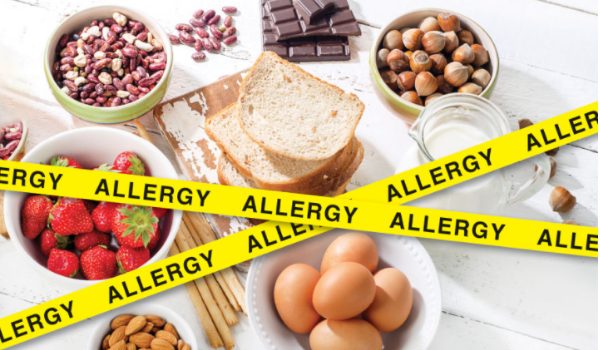Our lives now demand more travel and an increased range of lifestyle products and diets. Products manufactured at the industrial scale that we touch and consume daily also increase the risk of allergens. The risk of fatal allergic reactions is a genuine threat for the food and beverage industry.
An allergy or allergic reaction is an abnormal immune system response to a perceived foreign object. This object can be from either organic or inorganic sources. The substance or stimulant in allergic reactions is an allergen. An estimated 10-30%of the global population is prone to allergic reactions. These reactions are either caused by food or chemicals present in a range of products. They could range from eggs and nuts to paints and oils. Some of the common allergens found in our environment are:
Some of the common allergens found in our environment are:
- Dust, animal dander, pollen
- Food protein allergens in eggs, nuts, seafood.
- Chemical allergens are found in paints, polishes among others.
Allergy is more often than not thought to be caused more by food consumption than any other sources.
The risks that are brought on by the consumption of allergens. In the sections that follow, we shall look at how the F&B industry mitigates these risks. These include using industry standards and practices to document and help consumers identify potential allergens.
Allergen Management
Any allergen management program across industries is a documented, scientific approach. The goal is to identify, control and communicate the risk of allergens in the final product. The final product could be any packaged or manufactured product. This meaning virtually covers the entire breadth of the supply chain involved, from raw materials to finished goods.
The most important and often the only step in the management of allergy is avoidance of allergens. Allergen management in industries is mainly based on identifying allergens and effective communication. Consumers need to be made aware of such allergens’ presence so they can take appropriate steps to avoid exposure.
Businesses in the food and beverage industry have to steer clear of any allergy-related complications. Any severe incident brought out publicly on social media might dent market reputation and brand image. The food and beverage industry will benefit from a robust and effective allergen management system. A system that tracks all constituent ingredients and the vendors and suppliers that it originates from.
An effective allergen management system
An effective allergen management system ensures the thorough identification of allergens. It also provides appropriate communication through concise package labeling. It ensures that no food item, processed or packaged, gets to the consumer without allergen-specific messaging. It is also crucial for the business to ensure that the quality of constituent ingredients is not compromised at any stage of the supply chain.
An effective allergen management system in the F&B industry tracks the production and packaging through the supply chain. Some of the key areas that an allergen management system should govern are listed below:
- Raw Materials
Raw materials or constituent ingredients may be one of the allergens. All ingredients, along with their allergen status, need to be documented. This process should also involve permitted chemicals like food additives, preservatives, and the likes. Suppliers or vendors might change the source or quality of raw materials. Therefore, businesses should carry a regular periodic review of raw materials. These reviews help maintain up-to-date information about possible allergens.
- Threats posed by suppliers and vendors
The supplier’s facility could be another source of allergens. An allergen management system should consider these vulnerabilities too. It should detail any possible exposure to allergens at all such facilities. This approach means identifying and documenting all kinds of materials being supplied by the supplier. Even materials that are provided to other businesses. Cross contact at such facilities is a real possibility that they must not ignore.
- Production Procedures
Production and packaging processes that involve allergens are required to be well documented. Any process related to the handling of a food product is capable of introducing allergens. This process includes receipt, safe storage, preparation, processing, packaging, labeling, and dispatch. Cross-contact in storage, transportation, rework, and maintenance activities are possible. These possibilities need to be assessed and documented as well.
- Post Production Processes
The Allergen Management program should document all post-production cleaning procedures. Ideally, it should include the equipment, utensils, contact surfaces, food contact, and non-food contact surfaces. Such a program should also include the cleaning agents used. Businesses should also take into account accidental allergen contacts caused due to spills. The allergen management program should consist of regular and periodic verification of cleaning procedures.
- Product Labelling
Identification and isolation of allergens are the keys to avoiding adverse effects of allergens. Effective and appropriate labeling of finished products helps consumers identify allergens. The allergen management program should include procedures for effective labeling. This labeling should be concise and effective, along with appropriate advisory.
- Periodic Review of Allergen Management program
- An effective allergen management program should allow for periodic auditsand reviews. Existing documentation of processes and procedures should besubject to systematic reviews. These reviews help to detect any loopholes inthe existing program. It also helps keep the program up-to-date and effective.Ideally, any allergen management program should be reviewed whenever thefollowing conditions manifest.
- Consumer complaints received of allergic reactions
- Change in raw materials used
- Change in suppliers of raw materials used
- Change in the process of producing or packaging the food product
- Change in any resources like staffing or equipment, including machinesand containers
- Change in storage locations.
- Change in cleaning practices and processes
- Education of Food handling staff
Any effective allergen management program should also strive to educate all workforce involved. This management program should include all involved in handling the food product from production to packaging. The crew should be made aware of possible allergens and the risk their risk to consumers. An educated and knowledgeable staff will help in keeping processes and controls airtight and foolproof.
The HACCP Plan
HACCP (Hazard Analysis Critical Control Point) is an industry-standard process control system. It identifies hazards in the food production and packaging process. It also advocates the implementation of stringent measures to avoid dangers from taking place. Strict monitoring and control of every step in the process minimize the risk of hazards.
HACCP also mandates the identification of allergens that can cause hazards. Like any effective allergen management program, the HACCP plan identifies all potential risks. This approach includes hazards caused by allergens at each step of the production process.
Conclusion
Consumers today are ever more aware of what they consume in their day-to-day lives. The consumer feels that food producers owe them complete and transparent information. They expect all relevant information about ingredients and possible allergens, and rightly so. A practical and robust allergen management program is critical to product success. Identifying and appropriate labeling of allergens involved helps gain consumer trust and loyalty.

Sangeetha brings 20 years of experience in Information Technology which includes Solution architecting, building micro services, research, and evaluation of business applications, integrating apps.

